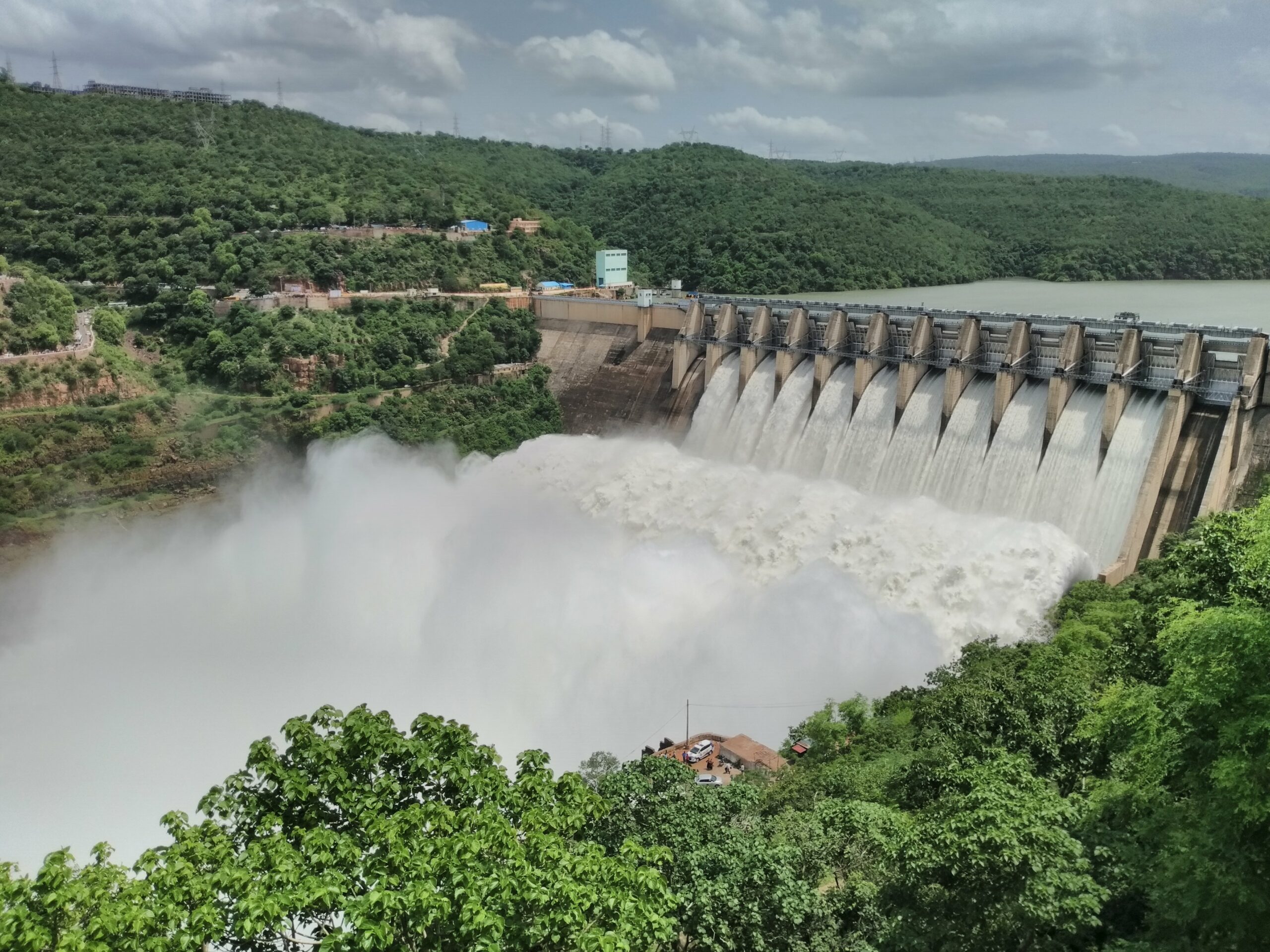The Telangana government wrote to the Union Jal Shakti Ministry on Monday, 7 July, urging it to initiate steps to repair the crater.
Published Jul 10, 2025 | 12:13 AM ⚊ Updated Jul 10, 2025 | 12:13 AM

The inflows into the project at about 4:10 pm on Tuesday, 8 July, were 173,351 cusecs and outflows, 87,897 cusecs.
Synopsis: A crater formed near the plunge pool of the dam has been of serious concern. No concrete steps have been taken to fix the issue that could affect the dam’s base.
Renewed fears about the structural safety of the Srisailam Dam have necessitated the release of excess water, even as heavy inflows continued into the reservoir.
Though the reservoir has been releasing water, a crater formed near the plunge pool remained unrepaired.
Expressing concern over the dam’s stability, the Telangana government wrote to the Union Jal Shakti Ministry on Monday, 7 July, urging it to initiate steps to repair the crater.
Located about 60 metres downstream, the void was now 400 meters wide, going to a depth of 143 feet near spillway gates 7 to 10. The cavity began forming after the unprecedented floods in the Krishna River in 2009, when the dam handled a discharge of a mind-boggling 25 lakh cusecs of water.
Engineers warned that the erosion was inching closer to the dam’s base, risking structural collapse if unchecked.
Irrigation Minister N Uttam Kumar Reddy, after conferring with officials, sought the Centre’s intervention for the dam’s safety in the wake of the National Dam Safety Authority (NDSA) recommending urgent repairs to the depression.
In its letter to the Jal Shakti Ministry, the government recalled its earlier pleas to the Krishna River Management Board and the state dam safety organization’s request to the NDSA for action.
With Chief Minister N Chandrababu Naidu releasing floodwaters from Srisailam on Tuesday, 8 July, after performing a jala harathi to the river, the void at the plunge pool was likely to take the full impact of the water gushing down the sluice gates. The inflows into the project at about 4:10 pm on Tuesday, 8 July, were 173,351 cusecs and outflows, 87,897 cusecs.
The Srisailam Dam, a vital reservoir for irrigation, drinking water, and hydropower in Telangana and Andhra Pradesh, has become a flashpoint between the two Telugu states. In April 2025, NDSA Chairman Anil Jain, after inspecting the site, called the depression at the plunge pool a “high-risk void” that could pose a problem to the stability of the dam during peak inflows.
Telangana accused Andhra Pradesh of ignoring NDSA’s directives to repair the plunge pool, while Andhra Pradesh said it was committed to repairing the depression. Naidu, on June 7, asked the officials to raise funds from the World Bank for the repairs, but not much progress has been reported since then.
The most recent and specific estimate for plunge pool restoration has been about ₹200 crore for the first phase. In February 2025, Telangana’s irrigation department warned that neglecting the plunge pool could weaken the dam’s foundation.
AP Irrigation Adviser N Kannaiah Naidu, who inspected the project on 6 July, described the leaks reported in February 2025 as manageable (less than 10 percent of gate capacity). Three of the dam’s 12 radial crest gates (No. 5, 6, and 10) developed leaks, with Gate No. 10 leaking significantly.
Kannaiah Naidu urged replacing all crest gates within five years. He said regular maintenance was necessary, like at the Tungabhadra Dam, where he had worked for a long time in various capacities.
The NDSA’s May 2025 report underscored the need to reinforce the plunge pool to prevent downstream flooding and protect critical infrastructure, including Nagarjuna Sagar and Pulichintala dams. NDSA Chairman Anil Jain also proposed building an access road to the plunge pool for easier maintenance and inspections.
The issue merited attention once again on 8 July when the Andhra Pradesh chief minister opened the dam’s crest gates, releasing flood waters downstream. Though there may not be any immediate danger to the safety of the dam, allowing the cavity at the plunge pool to remain unattended might further heighten the risk.
Previous mitigation efforts, including steel cylinders filled with concrete, have failed, with many units damaged or swept away. The NDSA has urged immediate action, recommending cement concrete tetrapods to stabilize the pool and halt further erosion.
A tetrapod is a four-legged structure, typically made of concrete, used in engineering and coastal management to protect structures like dams, breakwaters, or shorelines from erosion and wave impact. They are large, precast concrete units with a distinctive four-pronged, star-like shape. Each “leg” extends outward, allowing multiple tetrapods to interlock when placed together, creating a stable, porous barrier that dissipates the energy of high-velocity water flows.
In 2018, a National Institute of Oceanography survey confirmed deep scour zones. Recently, the Indian Institute of Information Technology, Design and Manufacturing (IIITDM) used an underwater drone to map the pool, revealing its expansion. On 26 June 2025, another survey by a different organization revealed an erosion of up to five metres below the original riverbed between spillway blocks 9 and 13.
(Edited by Majnu Babu).
